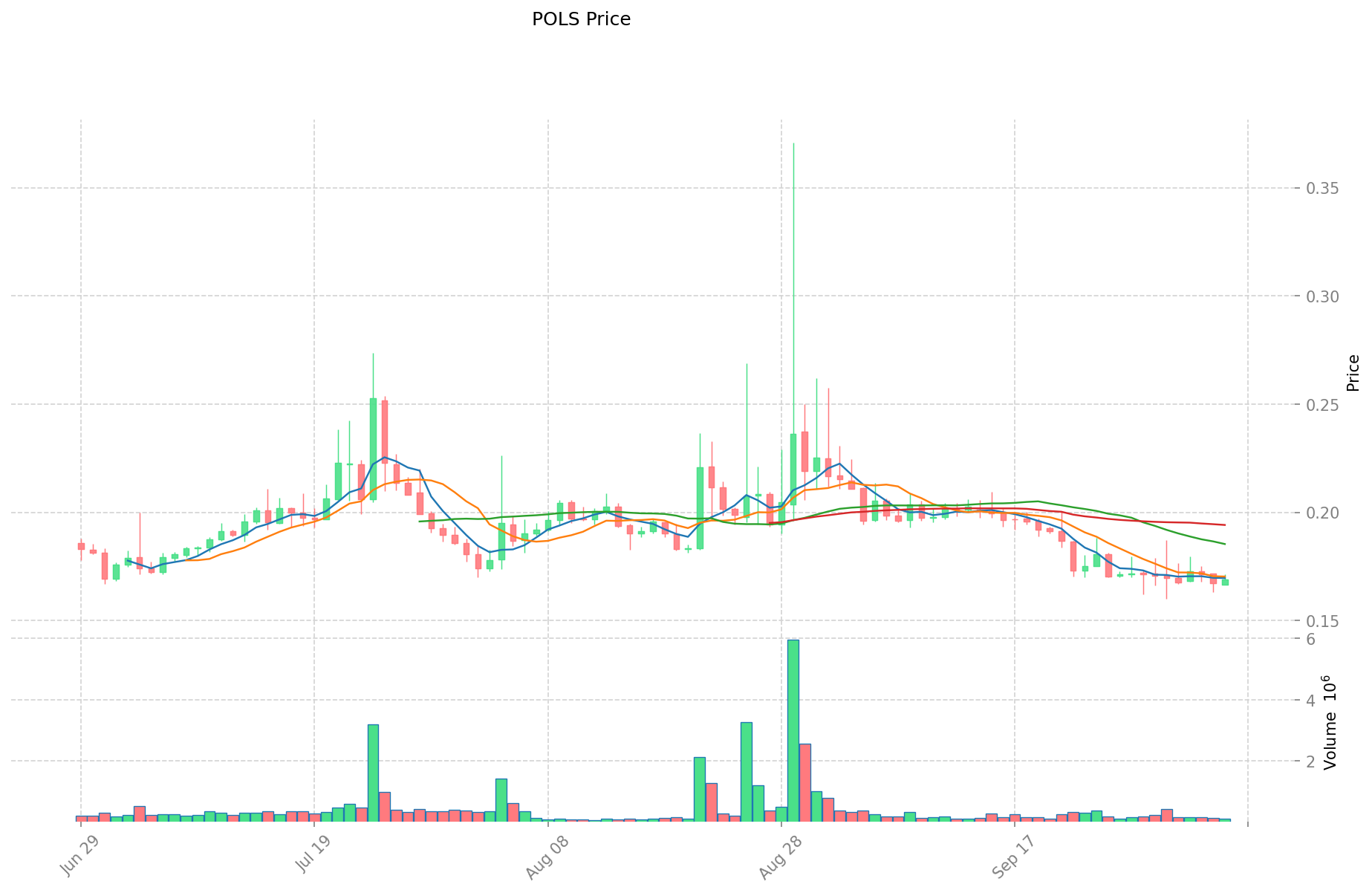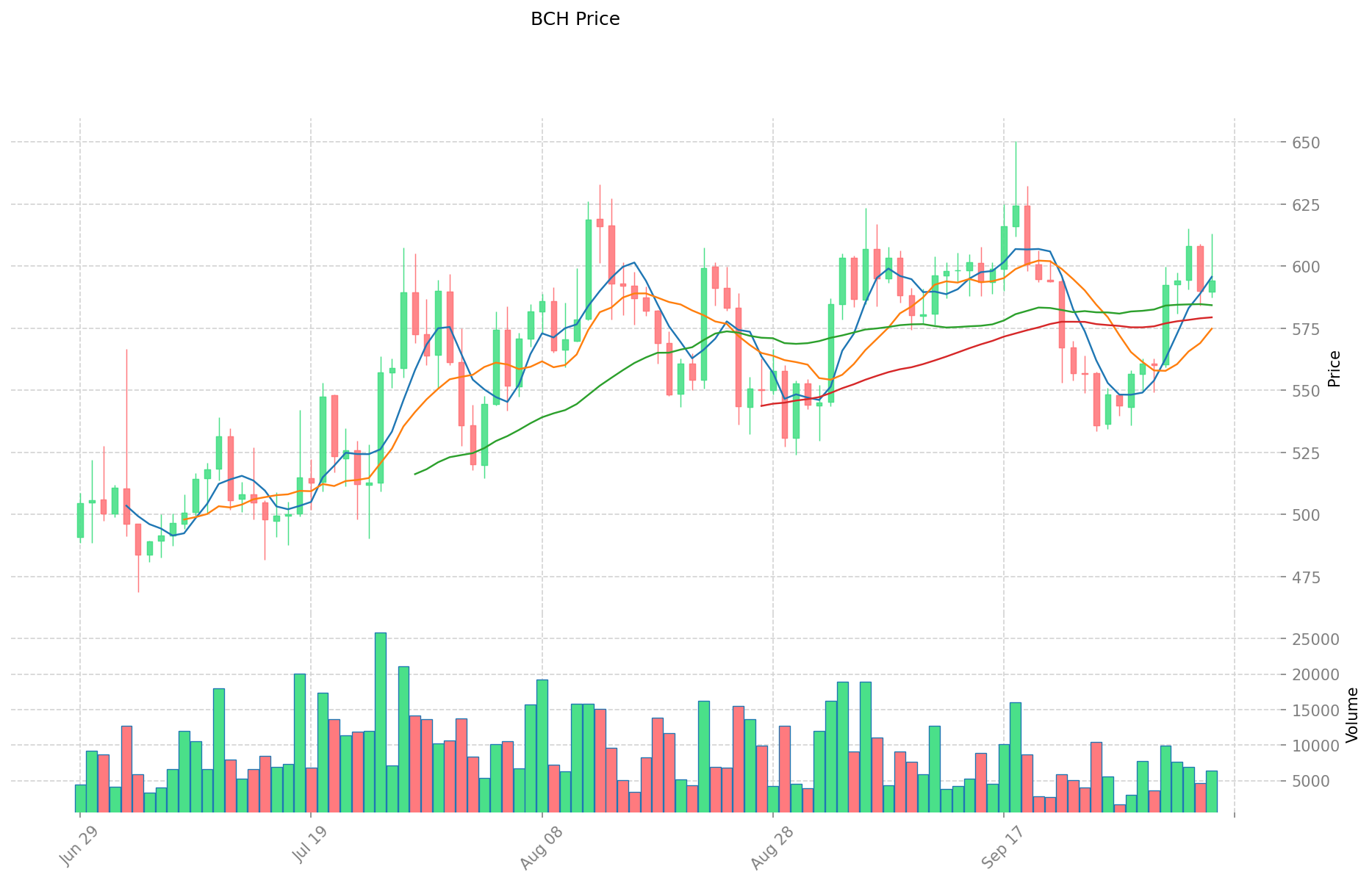POLS vs BCH: Analyzing Trading Patterns and Market Performance of Two Emerging Cryptocurrencies
Introduction: POLS vs BCH Investment Comparison
In the cryptocurrency market, the comparison between Polkastarter (POLS) and Bitcoin Cash (BCH) has always been an unavoidable topic for investors. The two not only have significant differences in market cap ranking, application scenarios, and price performance, but also represent different cryptocurrency positioning.
Polkastarter (POLS): Since its launch in 2020, it has gained market recognition for its role in launching and managing IDOs (Initial DEX Offerings).
Bitcoin Cash (BCH): Launched in 2017, it has been hailed as a fast and low-cost payment system, and is one of the cryptocurrencies with the highest global trading volume and market capitalization.
This article will comprehensively analyze the investment value comparison between POLS and BCH, focusing on historical price trends, supply mechanisms, institutional adoption, technological ecosystems, and future predictions, attempting to answer the question investors are most concerned about:
"Which is the better buy right now?"
I. Price History Comparison and Current Market Status
Historical Price Trends of POLS (Coin A) and BCH (Coin B)
- 2021: POLS reached its all-time high of $7.51 due to the booming IDO market.
- 2017: BCH was created through a hard fork of Bitcoin, with an initial price around $555.89.
- Comparative analysis: During the 2022 bear market, POLS dropped from its peak to a low of $0.116476, while BCH declined from its all-time high of $3,785.82 to a low of $76.93.
Current Market Situation (2025-10-06)
- POLS current price: $0.1691
- BCH current price: $593.09
- 24-hour trading volume: $21,183,309 (POLS) vs $3,864,011,335 (BCH)
- Market Sentiment Index (Fear & Greed Index): 74 (Greed)
Click to view real-time prices:
- View POLS current price Market Price
- View BCH current price Market Price


Comparative Analysis of POLS and BCH Investment Value
I. Core Factors Affecting POLS vs BCH Investment Value
Supply Mechanisms (Tokenomics)
- POLS: Algorithmic trading mechanisms driven by market dynamics and machine learning algorithms
- BCH: Fixed supply with similar mechanics to Bitcoin, focused on payment functionality
- 📌 Historical Pattern: BCH follows more traditional cryptocurrency supply patterns while POLS is more responsive to algorithmic trading signals and market analysis.
Institutional Adoption and Market Applications
- Institutional Holdings: BCH has greater recognition as a Bitcoin fork with established payment use cases
- Enterprise Adoption: BCH offers advantages in payment processing and transaction efficiency, while POLS serves more specialized trading functions
- Regulatory Stance: BCH faces similar regulatory frameworks as other major cryptocurrencies, with varying acceptance globally
Technical Development and Ecosystem
- POLS Technical Features: Trading algorithms that analyze support levels, trading volumes and market dynamics to identify optimal trading opportunities
- BCH Technical Development: Focus on blockchain technology for payment solutions with emphasis on transaction capacity and speed
- Ecosystem Comparison: BCH has more developed payment infrastructure while POLS serves specialized trading and investment functions
Macroeconomic Factors and Market Cycles
- Inflation Performance: BCH shares some Bitcoin characteristics as a potential inflation hedge
- Monetary Policy Impact: Both assets are affected by Federal Reserve policies, with interest rate cycles showing negative correlation with crypto asset prices
- Geopolitical Factors: BCH has greater potential for cross-border payment utility in uncertain geopolitical environments
II. Valuation Models and Investment Considerations
Bitcoin-Based Valuation Models Applicable to BCH
- Stock-to-Flow Model: Evaluates scarcity and supply growth rate
- Metcalfe's Law: Values network based on user adoption and transaction activity
- Mining Cost Analysis: Considers production costs including electricity consumption
Long-Term Investment Outlook
- BCH value is primarily driven by its utility as a payment method and blockchain technology applications
- POLS investment case relies more heavily on market dynamics, trading algorithm performance, and specialized use cases
- Both assets should be evaluated within broader cryptocurrency market cycles and macroeconomic conditions
III. 2025-2030 Price Prediction: POLS vs BCH
Short-term Prediction (2025)
- POLS: Conservative $0.145684 - $0.1694 | Optimistic $0.1694 - $0.181258
- BCH: Conservative $429.084 - $595.95 | Optimistic $595.95 - $774.735
Mid-term Prediction (2027)
- POLS may enter a growth phase, with estimated prices ranging from $0.1847091015 to $0.24269916825
- BCH may enter a bullish market, with estimated prices ranging from $731.397516 to $1009.646571
- Key drivers: Institutional capital inflow, ETF, ecosystem development
Long-term Prediction (2030)
- POLS: Base scenario $0.327496485717843 - $0.471594939433695 | Optimistic scenario $0.471594939433695+
- BCH: Base scenario $1066.45429556745 - $1279.74515468094 | Optimistic scenario $1279.74515468094+
Disclaimer: This information is for educational purposes only and should not be considered as financial advice. Cryptocurrency markets are highly volatile and unpredictable. Always conduct your own research before making any investment decisions.
POLS:
| 年份 | 预测最高价 | 预测平均价格 | 预测最低价 | 涨跌幅 |
|---|---|---|---|---|
| 2025 | 0.181258 | 0.1694 | 0.145684 | 0 |
| 2026 | 0.25422705 | 0.175329 | 0.12097701 | 3 |
| 2027 | 0.24269916825 | 0.214778025 | 0.1847091015 | 27 |
| 2028 | 0.34082050897125 | 0.228738596625 | 0.16697917553625 | 35 |
| 2029 | 0.370213418637562 | 0.284779552798125 | 0.145237571927043 | 68 |
| 2030 | 0.471594939433695 | 0.327496485717843 | 0.176848102287635 | 93 |
BCH:
| 年份 | 预测最高价 | 预测平均价格 | 预测最低价 | 涨跌幅 |
|---|---|---|---|---|
| 2025 | 774.735 | 595.95 | 429.084 | 0 |
| 2026 | 904.6521 | 685.3425 | 657.9288 | 15 |
| 2027 | 1009.646571 | 794.9973 | 731.397516 | 34 |
| 2028 | 1010.60056776 | 902.3219355 | 631.62535485 | 52 |
| 2029 | 1176.4473395049 | 956.46125163 | 918.2028015648 | 61 |
| 2030 | 1279.74515468094 | 1066.45429556745 | 757.1825498528895 | 79 |
IV. Investment Strategy Comparison: POLS vs BCH
Long-term vs Short-term Investment Strategies
- POLS: Suitable for investors focused on trading algorithms and specialized market functions
- BCH: Suitable for investors seeking payment utility and blockchain technology applications
Risk Management and Asset Allocation
- Conservative investors: POLS: 20% vs BCH: 80%
- Aggressive investors: POLS: 40% vs BCH: 60%
- Hedging tools: Stablecoin allocation, options, cross-currency portfolios
V. Potential Risk Comparison
Market Risks
- POLS: Higher volatility due to specialized trading functions and market dynamics
- BCH: Susceptible to broader cryptocurrency market trends and Bitcoin price movements
Technical Risks
- POLS: Algorithmic trading risks, platform stability
- BCH: Mining centralization, potential security vulnerabilities
Regulatory Risks
- Global regulatory policies may have different impacts on both assets, with BCH potentially facing more scrutiny as a payment-focused cryptocurrency
VI. Conclusion: Which Is the Better Buy?
📌 Investment Value Summary:
- POLS advantages: Specialized trading functions, algorithmic trading potential
- BCH advantages: Established payment utility, larger market cap, broader adoption
✅ Investment Advice:
- New investors: Consider a conservative allocation favoring BCH for its established market presence
- Experienced investors: Balanced portfolio with both assets, leveraging POLS for potential higher returns
- Institutional investors: Strategic allocation based on specific investment goals, with BCH potentially serving as a more liquid, established asset
⚠️ Risk Warning: The cryptocurrency market is highly volatile. This article does not constitute investment advice. None
FAQ
Q1: What are the key differences between POLS and BCH? A: POLS is focused on algorithmic trading and IDO management, while BCH is primarily a payment-oriented cryptocurrency. POLS has a smaller market cap and higher volatility, whereas BCH has broader adoption and a larger trading volume.
Q2: Which asset has performed better historically? A: BCH has demonstrated better long-term performance and stability. It reached an all-time high of $3,785.82, compared to POLS's peak of $7.51. However, both assets experienced significant declines during the 2022 bear market.
Q3: How do the supply mechanisms differ between POLS and BCH? A: POLS utilizes algorithmic trading mechanisms driven by market dynamics and machine learning algorithms. BCH has a fixed supply similar to Bitcoin, focusing on payment functionality.
Q4: What are the main factors affecting the investment value of these assets? A: Key factors include supply mechanisms, institutional adoption, technical development, ecosystem growth, macroeconomic conditions, and regulatory environments. BCH is more influenced by its payment utility, while POLS is affected by trading algorithm performance and market dynamics.
Q5: How do the long-term price predictions compare for POLS and BCH? A: By 2030, POLS is predicted to reach a base scenario of $0.327496485717843 - $0.471594939433695, while BCH is expected to reach $1066.45429556745 - $1279.74515468094. However, these predictions are subject to market volatility and should be approached with caution.
Q6: Which asset is considered more suitable for different types of investors? A: Conservative investors may prefer a larger allocation to BCH due to its established market presence. Experienced investors might consider a balanced portfolio with both assets. POLS may be more suitable for those interested in specialized trading functions and higher risk-reward potential.
Q7: What are the primary risks associated with investing in POLS and BCH? A: Both assets face market risks related to cryptocurrency volatility. POLS has additional risks associated with algorithmic trading and platform stability. BCH may face regulatory scrutiny due to its payment focus. Technical risks include potential security vulnerabilities for both assets.
Share
Content